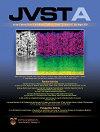利用衬底提高清洁、无缺陷外延石墨烯的反应性-实验与理论
IF 2.1
3区 材料科学
Q3 MATERIALS SCIENCE, COATINGS & FILMS
引用次数: 0
摘要
实验和理论证明了一种硫化合物在超高真空(UHV)条件下在干净、无缺陷的外延石墨烯(Gr)上解离。结合密度泛函理论计算(DFT)、实验动力学和光谱数据表明,这是一个自(/自)催化过程。这一结果可能为碳催化剂开辟了一条途径。在超高压低温下,单层石墨烯/钌(Gr/Ru)吸附H2S时,H2解吸,硫留在表面。空位和晶界缺陷可以分别被排除为活性位点。DFT结果表明Ru(0001)载体在促进具有小活化能的H2S解离反应途径中的重要性。Gr的反应是由于结构和电子效应的复杂相互作用,包括石墨烯层的波纹和钌的d轨道与H2S反键态的杂化。本文章由计算机程序翻译,如有差异,请以英文原文为准。
Enhancing the reactivity of clean, defect-free epitaxial graphene by the substrate—Experiment and theory
Experimental and theoretical evidence is presented that a sulfur compound dissociates on clean, defect-free epitaxial graphene (Gr) in ultrahigh vacuum (UHV). Together with density functional theory calculations (DFT), experimental kinetics and spectroscopic data suggest an auto-(/self)catalytic process. The results could open a pathway to a carbocatalyst. While adsorbing H2S in UHV at low temperatures on single-layer graphene/ruthenium (Gr/Ru), H2 desorbs and sulfur remains on the surface. Vacancy and grain boundary defects, respectively, can be excluded as active sites. DFT results indicate the importance of the Ru(0001) support in facilitating a reaction pathway with small activation energy for H2S dissociation. Gr becomes reactive due to a complex interplay of structural and electronic effects, including the corrugation of the graphene layer and the hybridization of ruthenium's d orbital with antibonding states of H2S.
求助全文
通过发布文献求助,成功后即可免费获取论文全文。
去求助
来源期刊

Journal of Vacuum Science & Technology A
工程技术-材料科学:膜
CiteScore
5.10
自引率
10.30%
发文量
247
审稿时长
2.1 months
期刊介绍:
Journal of Vacuum Science & Technology A publishes reports of original research, letters, and review articles that focus on fundamental scientific understanding of interfaces, surfaces, plasmas and thin films and on using this understanding to advance the state-of-the-art in various technological applications.
 求助内容:
求助内容: 应助结果提醒方式:
应助结果提醒方式:


